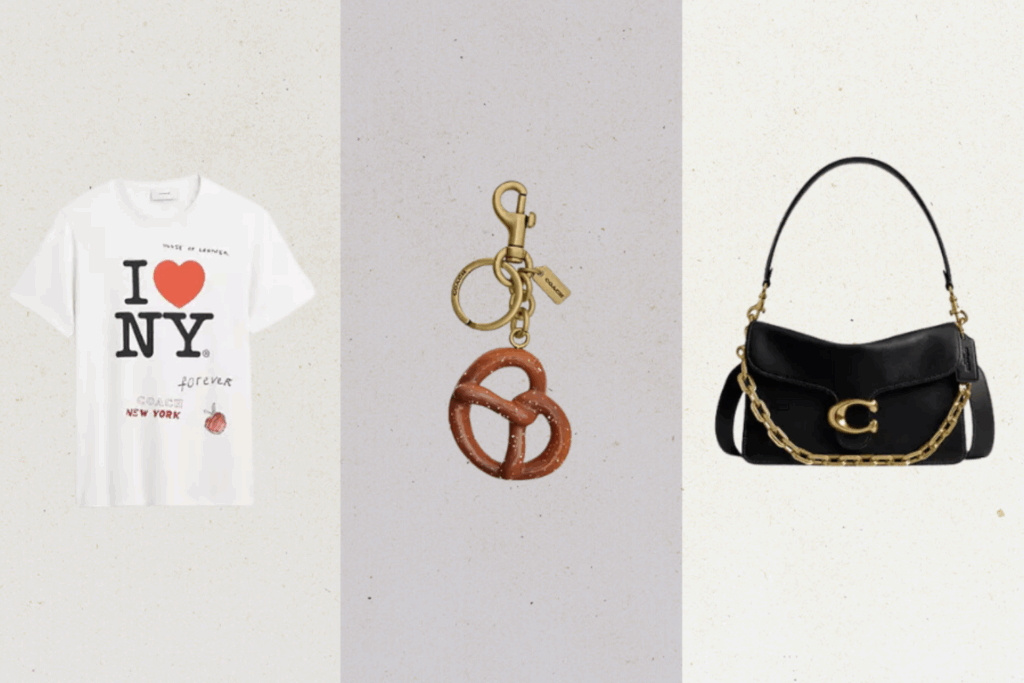From outlet brand burnout to TikTok virality and Gen Z obsession, Coach’s resurgence is a case study in how legacy brands can pivot through product design, creator culture, and platform-native strategy.

Coach: The Brand That Fell (Then Flew Again)
When my husband and I first started dating, he gave me a Coach purse as a gift for our anniversary. It was a deep green shade, crafted from soft but structured leather, and he was thrilled that it was made from the same leather used for baseball gloves. At the time, it felt classic. And since I was in my 30s, it also felt aspirational in a way that signaled I was stepping into something more grown-up. It was structured, strong, and made a quiet statement: confident, timeless, and understated. I hadn’t seen a Coach bag outside of a store in years, but this one was beautiful. I still use it as my fall bag, and I love that it came with two straps for different applications. Since then, I’ve become the proud owner of multiple Coach bags, each one feeling like a little design victory. And yes, I’ve been eyeing the viral Brooklyn 39 bag for a while now—Santa, if you’re reading this, I’ve been very good.
Years later, watching Coach rise again, not through hype, but through restraint and relevance, feels like that bag all over again: quiet, solid, and ahead of its time.
Coach didn’t fall overnight. In the early 2000s, it was a name synonymous with status—a fixture on celebrity arms and suburban mall wishlists alike. The brand’s Signature ‘C’ bags were everywhere, but that ubiquity soon turned toxic. Saturation led to devaluation, and what was once aspirational began to feel cheap. By the 2010s, Coach had become a victim of its own success, overshadowed by outlet markdowns and dated designs. It was no longer in the conversation.
One Reddit user captured the sentiment bluntly:

That perception lingered for years, despite quiet improvements in quality and design.
But comebacks in fashion are never just about trends. They’re about timing, narrative, and identity. And Coach’s re-entry into cultural relevance was a multi-year, multi-platform reinvention.
In early 2024, a Reddit thread captured the shift in real time. Users weren’t reacting to a marketing campaign—they were realizing Coach had quietly evolved. “I used to think it was just for moms,” one comment read, “but the last few seasons? Honestly, the leather is better than some ‘real’ luxury brands.” Another chimed in: “The moment I saw the Pillow Tabby, I realized Coach wasn’t playing anymore.” Coach’s intended audience was building the comeback story for them. I think the full quote from above says it best:

By 2023, the Pillow Tabby had become a viral sensation on TikTok. Paris Hilton was fronting campaigns again. Gen Z was proudly carrying their lines. It was a brand reborn, not because it chased youth, but because it strategically evolved its story and medium.

The legend herself
What’s Happening: The Coach Rebrand in Motion
- Nostalgia, Repackaged: Coach leaned into the Y2K revival without falling into parody. Reissues of the Swinger and Tabby bags brought back familiar silhouettes, but in muted tones, updated structures, and less aggressive logo placement.
- Celebrity Credibility: The brand didn’t just partner with celebrities—it picked culture-shapers. Jennifer Lopez, Megan Thee Stallion, Lil Nas X, and Michael B. Jordan weren’t just fashion names—they represented identity, transformation, and individuality.
- TikTok Virality: “What’s in my Tabby?” became a storytelling prompt, not just a product plug. From 19M views in 2022 to 464M in 2023, Coach’s video content didn’t just scale—it resonated. Its TikTok response rate hit 1.25%, far above industry norms.
- Smart Distribution Moves: By reducing outlet sales and focusing on curated drops, Coach reintroduced scarcity. The result? Elevated perception without alienating aspirational buyers.
- Customization & Experience: Coach Play and Coach Coffee weren’t gimmicks—they were signs of lifestyle ambition. With personalization trends spiking (Pinterest searches for “bag charm ideas” +10,000%), Coach invited consumers to co-create identity, not just style.
Redditors consistently called out the shift in-store:

Coach didn’t shout about its upgrades—it let consumers discover them, a tactic that built trust organically.
Brand and Marketer Implications
The Coach comeback isn’t just inspirational—it’s instructive.
- Relevance > Reach: In 2025, Coach’s follower growth slowed—but relevance held. This proves brands don’t need to go viral every year if they build something deeper.
- Heritage Needs Restraint: Coach’s restraint was strategic. Nostalgia wasn’t used as a crutch—it was used as a hook, reimagined through a modern lens.
- Product Is Still the Strategy: Coach didn’t rebrand through slogans—it did it through silhouettes. The Tabby was a physical manifestation of the brand’s shift: playful, bold, familiar, and refined.
- From Virality to Value: When video views dipped 20% YoY in 2025, Coach didn’t panic. Instead, it doubled down on experience and product storytelling, proving that longevity comes from layered brand equity—not always louder content.
Platform and Cultural POV
- TikTok as Image Rehab: Coach didn’t advertise its way back into fashion—it memed its way in. It invited audiences to remix, restyle, and reframe the product, building trust through creator collaboration and UGC.
- The Emotional Luxury Era: Coach campaigns tapped into vulnerability—identity, chosen family, freedom of expression. Gen Z didn’t just buy the bag; they bought the narrative around it.
- Affordable Aspiration: Coach found a lane: less expensive than Prada, more stylish than Zara. It exists in that narrow—and growing—space of ‘cool but attainable,’ which speaks directly to post-pandemic consumer psychology.
One Redditor summed it up best:

Key Takeaways for Marketers
- Viral isn’t sustainable—brand equity is.
- Use heritage, but remix it for now.
- Give your product a story that users can retell.
- TikTok is a brand tool, not just an awareness play.
- Reduce volume, increase cultural precision.
- Extend brand touchpoints beyond the product—into experience, community, and lifestyle.
Final Thought
Coach’s return wasn’t just about great bags. It was about a brand relearning how to tell a story that mattered, on platforms that mattered, to people who had grown up without ever seeing it as cool. Its lesson is clear: reinvention is never just about trendspotting. It’s about reclaiming the narrative.
The people noticed. Quietly, at first. Then loudly.

For marketers: What part of your brand story are you still afraid to rewrite?
Coach Social Stats: 2022–2025 (YTD as of Nov 12)
| Metric | 2022 | 2023 | 2024 YTD | 2025 YTD |
| Total Followers | 15.9M (+9%) | 16.7M (+5%) | 17.4M (+4%) | 18.1M (+3%) |
| Follower Growth | 1.3M | 840K | 709K | 453K |
| Engagements | 7.35M | 10.84M | 7.38M | 4.81M |
| Public Video Views | 19M | 464M | 302M | 28M |
| Response Rate (TikTok) | 0.09% | 0.31% | 0.31% | 0.09% |
| New Posts | 2,394 | 1,929 | 1,248 | 1,071 |
| Brand Reputation Index | 88.36 | 88.59 | 88.84 | 88.81 |
Sources:
- ListenFirst Social Analytics Dashboard (2022–2025)
- CNBC: “Coach Comeback” (June 2025)
- Arcot Group: “How Coach Made a Stunning Comeback” (February 2025)
- Reddit: r/handbags discussion thread on Coach resurgence (2024)
- Pinterest Trends Report (2024–2025)
- Lyst Q4 Fashion Report (2024)
- PurseBlog: “The Coach Comeback” (2023)
- Varsity UK: Coach retrospective (2022)



